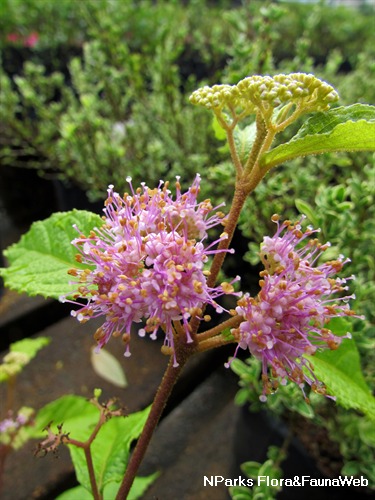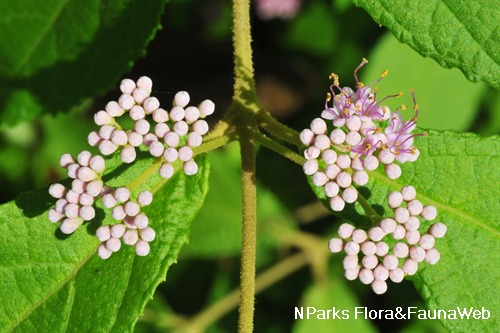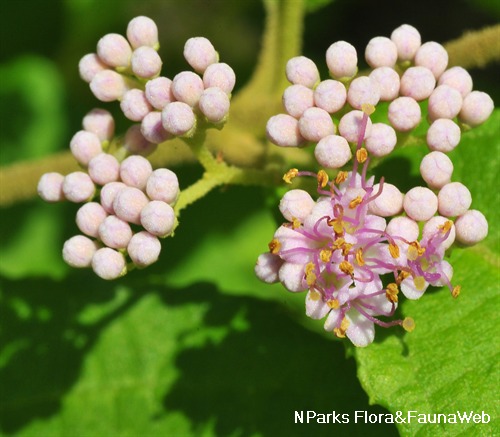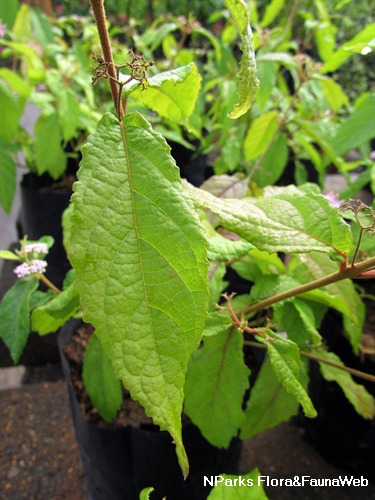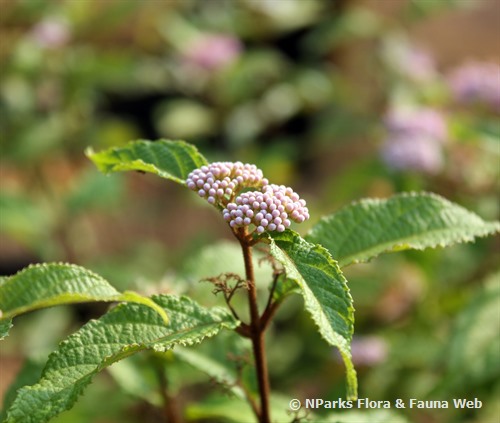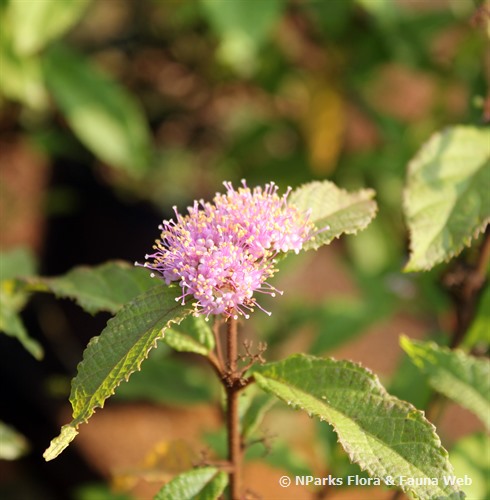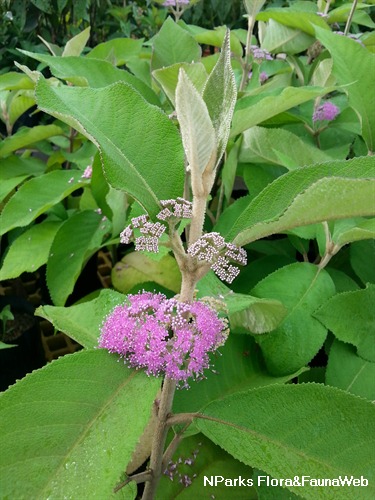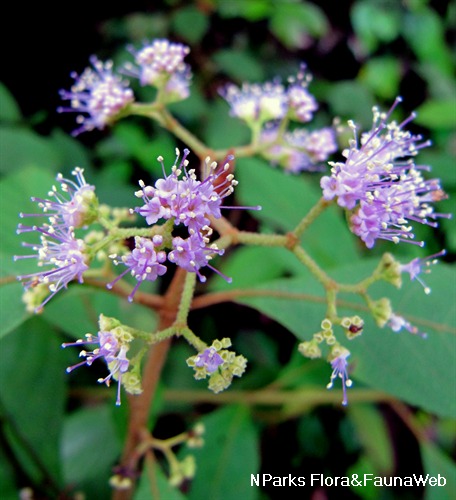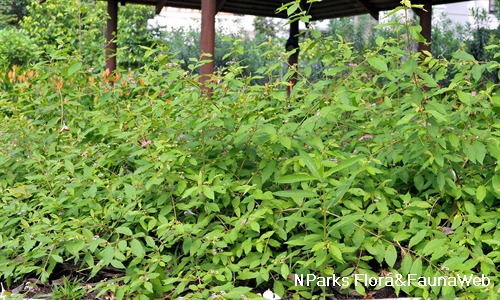
Back
Callicarpa pedunculata R.Br.
| Family Name: | Lamiaceae (Labiatae) |
| Synonyms: | Callicarpa formosana Rolfe |
| Common Name: | Beautyberry, Velvet Leaf, 杜虹花, 紫珠 |
Name
Classifications and Characteristics
| Plant Division | Angiosperms (Flowering Seed Plants) (Dicotyledon) |
|---|---|
| Plant Growth Form | Shrub |
| Lifespan (in Singapore) | Perennial |
| Mode of Nutrition | Autotrophic |
| Maximum Height | 1 m to 3 m |
Biogeography
| Native Distribution | Tropical & Subtropical Asia to Solomon Islands |
|---|---|
| Native Habitat | Terrestrial |
| Preferred Climate Zone | Tropical, Sub-Tropical / Monsoonal |
| Local Conservation Status | Non-native (Horticultural / Cultivated Only) |
Description and Ethnobotany
| Growth Form | Shrub up to 3 m tall. |
|---|---|
| Foliage | Leaves are ovate (egg-shaped) to elliptical (oval) or oblong-lanceolate (intermediate between elongated with parallel sides to lance-shaped). The leaf tip is wedge-shaped or narrowing to a short tip. The leaf underside is yellowish brown with a velvety texture. |
| Stems | Stems are covered in greyish yellow, wooly hairs. |
| Flowers | Small, light to medium purple flowers (2.5 mm long) are arranged in a 2-3 cm long inflorescence known as a cyme (3-4 cm wide). The petals are surrounded by 4 triangular sepals which form a cup-like structure covered in greyish yellow matted hairs. Each flower has 5 stamens which are about twice as long as the petals (5 mm long). The peduncle (stalk of the inflorescence) is longer than the petiole (leaf stalk). |
| Fruit | Purple, violet or pink fleshy berry-like fruits (2 mm wide) are actually drupes (fleshy fruits that contain hard pits with seeds inside). Round fruits (2-4 mm wide) are densely arranged in small clusters in or slightly above the leaf axil (the angle between the upper leaf surface and stem). |
| Etymology | The genus Callicarpa is derived from the Greek words 'kalli' meaning beautiful and 'karpos' meaning fruit. The species name refers to the attractive, often brightly coloured fruits produced by members of this genus. |
| Ethnobotanical Uses | Medicinal: According to folk medicine, the whole plant can be used to reduce pain and inflammation, as well as control internal bleeding. |
Landscaping Features
| Desirable Plant Features | Ornamental Flowers, Ornamental Fruits |
|---|---|
| Landscape Uses | General, Parks & Gardens, Container Planting, Small Gardens |
Fauna, Pollination and Dispersal
| Fauna Pollination Dispersal Associated Fauna | Bird-Attracting Plant (Fruits) |
|---|---|
| Pollination Method(s) | Biotic (Fauna) |
Plant Care and Propagation
| Light Preference | Full Sun, Semi-Shade |
|---|---|
| Water Preference | Moderate Water |
| Plant Growth Rate | Moderate |
| Rootzone Tolerance | Moist Soils, Well-Drained Soils |
| Propagation Method | Seed, Stem Cutting (Tip, Semi-Hardwood, Hardwood) |
Foliar
| Mature Foliage Texture(s) | Spiny / Bristly / Stinging |
|---|---|
| Foliar Type | Simple / Unifoliate |
| Foliar Attachment to Stem | Petiolate |
| Foliar Shape(s) | Non-Palm Foliage (Ovate, Lanceolate, Elliptical, Oblong) |
| Foliar Venation | Pinnate / Net |
| Foliar Margin | Serrate / Toothed |
| Foliar Apex - Tip | Acuminate, Caudate |
| Foliar Base | Cuneate, Rounded / Obtuse |
| Typical Foliar Area | Mesophyll ( 45cm2 - 182.25 cm2 ) |
Floral (Angiosperm)
| Flower & Plant Sexuality | Bisexual Flowers |
| Flower Colour(s) | Purple |
|---|---|
| Flower Texture(s) | Smooth |
| Flower Grouping | Cluster / Inflorescence |
| Flower Location | Axillary |
| Inflorescence Type | Cyme |
Fruit, Seed and Spore
| Mature Fruit Colour(s) | Purple |
|---|---|
| Mature Fruit Texture(s) | Smooth, Glossy / Shiny |
| Fruit Classification | Simple Fruit |
| Fruit Type |
References
| References | Munir, A.A. 1982. A taxonomic revision of the genus Callicarpa L. (Verbenaceae) in Australia. Journal of Adelaide Botanic Gardens. 6. 1. 5-39 |
|---|
Image Repository
Others
| Master ID | 31600 |
|---|---|
| Species ID | 5999 |
| Flora Disclaimer | The information in this website has been compiled from reliable sources, such as reference works on medicinal plants. It is not a substitute for medical advice or treatment and NParks does not purport to provide any medical advice. Readers should always consult his/her physician before using or consuming a plant for medicinal purposes. |

